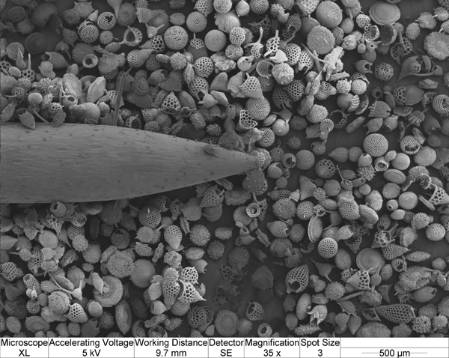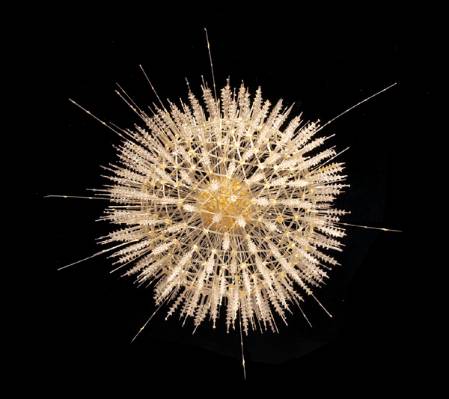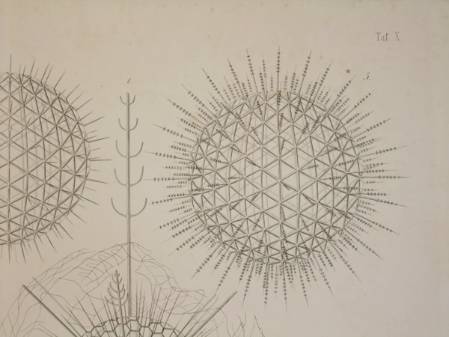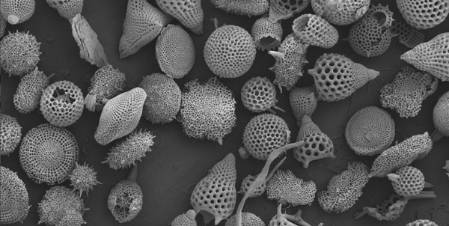The Museum radiolarian collection makes up considerably less than 1% of the total microfossil collection but is proving very popular at the moment. Last February we loaned some slides to accompany an exhibition by Irene Kopelman at the Gasworks Gallery and this week I processed a loan for Artist/PhD Researcher Gemma Anderson. Glass models of radiolarians made in 1889 by the father and son partnership of Leopold and Rudolf Blaschka are also being prepared for something special that will be happening later in the year at the Museum.
A scanning electron microscope image of part of the fossil radiolarian residue on loan to Gemma Anderson. The tip of a standard 0.65mm diameter dressmaking pin is included for scale.
Radiolarians are single celled organisms (Protozoa) that secrete tiny skeletons of opaline silica. They are present in the oceans of today from the tropics to the Arctic and live anywhere from near the surface to depths of several hundred metres. They range in size from 0.03mm to 2mm and mainly have a solitary floating lifestyle (planktonic), although some are colonial.
The living cell that produces the skeleton consists of a central mass of cytoplasm surrounded by a peripheral layer called the extracapsulum. Sometimes the extracapsulum contains bubble like structures that aid flotation and occasionally algal symbionts. The cells also produce radiating fine structures called axopodia. In some species these are contractile and may have been used to move organic particles closer to the extracapsulum for digestion.
Fine strands called fusules connect the extracapsulum with the inner capsule and these are unique to the Radiolaria. Modern radiolarians are subdivided based on the microanatomy of the central capsule whereas fossil forms are classified on skeletal characteristics. The living and fossil classification schemes are not intergrated as a result.
A Blaschka glass model of the radiolarian Aulosphaera elegantissima Haeckel, 1862. The central mass of cytoplasm, the axiopoda and the spherical silica shell are magnified about 500 times and reproduced in glass.
A collection of 18 radiolarian and heliozoan Blaschka glass models were acquired by the Museum in 1889. The Blaschkas made 10 different varieties of Radiolaria representing two of the three main subdivisions. They also offered three varieties of Heliozoa (literally sun animals). These look superficially like radiolarians but differ in the arrangement of the pseudo/axo-podia and the cellular structure in the central capsulum.
The illustration of A. elegantissima in Ernst Haeckel's 1862 monograph on the Radiolaria that provded the inspiration for their work.
Radiolarians are very beautiful to look at but are also scientifically significant. The have a long geological record stretching back more than 500 million years to the Cambrian Period. This makes them very useful for determining the age of sedimentary rocks that contain them as well as giving details of past climates and oceanographic conditions.
The Museum's radiolarian collection of 1,500 slides is small but historically very significant. Ernst Haeckel described 2,775 new radiolarian species in his 1887 monograph on the Challenger radiolarians [PDF] but did not define any type specimens. A set of teaching slides made by Haeckel in the Museum collection is the only set of plankton slides available from the Challenger Expedition. Residues in the Ocean Bottom Sediment Collection also contain important comparative specimens that help define Haeckel's species concepts in the absense of type specimens.
A close up of part of the radiolarian residue on loan to Gemma Anderson. It is from Miocene Barbados Marl which is roughly 15 million years old.
It will be very interesting to see the results of Gemma's study; I will comment on this blog with any details. I would also be very excited to see a Blaschka radiolarian model on display in the Museum galleries. I promise a more detailed post on the Museum Blaschka Collection in the future with a very interesting story involving a team of archivists, curators, conservators and exhibition staff (with some C-T scanning too).






